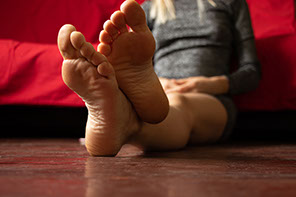Do you take your shoes off before entering your home? This practice is currently more prevalent in the United States than you might think. A CBS News Poll conducted in May 2023 revealed that more than six out of ten U.S. adults don’t wear shoes inside their homes. The decision to wear or not wear shoes inside is a personal one for each household.
Reasons for No Shoes
There are many motivations for removing your shoes before stepping inside. In Asian cultures, this tradition is a sign of respect. In Muslim homes, shoes are removed to keep the floor clean for prayer. Homeowners in snowy or wet climates remove soggy or ice-encrusted shoes before entering to protect floors. People in multi-story apartments remove shoes to reduce noise for neighbors who live below. Some people like to kick off their shoes and get comfortable after a long day at work. Family members with allergies are happy when pollen and other allergens aren’t tracked inside. Moreover, in a world where bacteria are flourishing and becoming increasingly resistant to antibiotics, many people wonder if we should avoid shoes in the house as a way to keep our families safe from disease.
Shoe Soles Harbor Germs
What does the science say about germs on the soles of shoes? Shoes do pick up harmful bacteria and increase transmission. A frequently-cited study from the University of Arizona monitored participants’ shoes for ten weeks. Escherichia coli or E. coli was a common finding on the outside of the shoes. This bacterium can cause GI tract infections, meningitis and other illnesses. Dr. Charles Gerba, a microbiologist and lead investigator, noted that, “The common occurrence (96%) of coliform and E. coli bacteria on the outside of the shoes indicates frequent contact with fecal material, which most likely originates from floors in public restrooms or contact with animal fecal material outdoors. Our study also indicated that bacteria can be tracked by shoes over a long distance into your home or personal space after the shoes were contaminated with bacteria.”
Another dangerous bacterium, Clostridioides difficile (C. diff), proliferates in urban settings. A study conducted by the Mayo Clinic in Houston, Texas, looked at C. diff contamination in households. Shoe bottoms had the highest percentage of C. diff followed by samples collected from bathroom and toilet surfaces. Because C. diff spores are resistant to many household cleaning products, the potential for household contamination is high. Another systematic review study found about 40% of shoe soles in non-healthcare settings were contaminated with this bacterium. C. diff causes infection of the large intestine.
Health Risks of Shoes Inside
the Home
When deciding if the “no shoes” policy is right for your home, consider your family’s situation. Banning shoes from entering your home will cut down on the amount of dust, dirt, allergens and bacteria that get tracked in. However, bacteria on your floors is only a health risk in certain circumstances.
If you have young children who play or crawl around on the floor, a “no shoes inside” policy will help protect them from getting dangerous bacteria on their hands or toys, which frequently end up in the mouth. Another reason to be careful is if anyone in your house is sick or has a compromised immune system.
Tips for Implementing a “No Shoes” Policy in Your Home
- Discuss with your family your reasons for leaving shoes at the door. Be patient as everyone gets in the habit of removing shoes before entering.
- Plan the logistics. Where will family members and guests put their shoes when they take them off? Designate a shelf or basket by the door. Provide a bench so people who wear lace-up shoes can sit down to remove or put on shoes.
- Decide if people will go barefooted inside, wear socks, or change into slippers. Consider safety for elderly family members or visitors who are at risk for falling.
- Don’t apologize for your “no shoes” policy. Although 90% of respondents in the CBS News Poll felt that asking someone to remove their shoes was a reasonable request, only 24% are comfortable asking their guests to do so.
Brenda Schoolfield is a medical writer and editor who lives in Austin. Sugar, her cocker spaniel and sometimes a rescue foster dog or two keep her company while she writes.

















